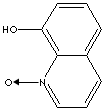PRODUCT IDENTIFICATION

H.S. CODE
TOXICITY
CLASSIFICATION
PHYSICAL AND CHEMICAL PROPERTIES
REFRACTIVE INDEX
NFPA RATINGS
AUTOIGNITION
FLASH POINT
Oxyquinoline, Hydroxyquinoline at 8- position, is used as a bacteriostatic and fungistatic agent. It is used in preparing antiseptics, deodorants, antiperspirants, and fungicides. The sulfate salt of 8-hydroxyquinoline is used as a complexing agent for pharmaceuticals. 8-Quinolinol is used as a precipitating agent or chelating agent to separate metals. It is also used in formulating anti-dandruff agents for shampoo. Amine N-oxides are active components in body care products such as shampoo, bubble bath, and hand-soap formulations in combination with alkyl or olefin sulfates. In acidic media, they are cationic and can act as a mild conditioner. In neutral or weak basic media, they are featured as excellent foam stabilizer and viscosity building provider.
APPEARANCE
CONTENT
98.0% min
MELTING POINT